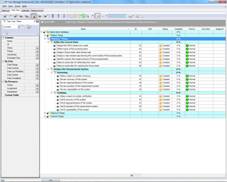|
Itís nearly impossible to efficiently plan for improvements without understanding the current state of a process or system. The second phase of the Sig Sigma project lifecycle is meant for solving this issue. It is called "Measure" and uses a series of tools to determine the current condition of a process/system planned for improvement by a Six Sigma based project. The Measure phase requires establishing baseline data to evaluate impact of the project to the process/system. Current performance goals will be evaluated and revised if needed. A measurement system combining a range of performance indicators and quality criteria will be established and validated to monitor the processís performance and control progress towards the project goals.
When you have defined the problem of your process/system and made a decision on initiating a Six Sigma project (so the previous, Define, phase is over) you can proceed to measuring the current state of that process/system. Implementation of the Measure phase can be done in 2 processes such as:
- Define the current state of the process/system
- Analyze the measurement system
Both processes of the Measure phase are convenient to manage if they are planned by simple, more manageable activities. For example, by using VIP Task Manager you can plan the processes by tasks that have a range of attributes for easier management. Letís describes the processes and find out what tasks can be created to perform the Measure phase of your Six Sigma project.
Define the current state of the process/system
First of all, you need to describe the current state of the process/system that you want to improve. To gain an understanding of the process/system you can use a value stream map (VSM), which is a lean manufacturing tool to analyze the flow of materials and information required for producing a product. Often manufacturing companies use VSM to identify where there is waste of materials and information (such as defects or errors, delays, reduced employee performance) in the manufacturing process and how to find ways to eliminate that waste.
In your Six Sigma project you can employ the value stream mapping technique to get a high-level look at the process/system and identify inputs and outputs. Inputs will be resources such as raw materials, people, funds, technology etc. Outputs will be the target product of your process/system. In your value stream map you can represent how inputs and outputs are linked to each other, that is what workflows are required to design and produce the product.
When you get VSM designed you can assess the current state of the process/system. By reviewing your VSM closer to ground level, you can perform a cause-effect analysis that helps identify any inputs that are critical to the final product and define potential areas for improvement. When you get this information you can create a flow of inputs that eliminate or minimize waste. In your VSM you can design a future state of the process/system and establish a measurement system that helps you assess your work towards the future condition. Such a system will include a range of metrics and data being monitored to measure the problem process/system and define if the forecasted state is appropriate and fits into desired performance of the process/system.
Analyze the Measurement System
The second process of the Measure phase is to examine the data in your measurement system. It includes two activities, such as:
The Reviewing activity means that you need to review the data of your measurement system to ensure it is appropriate and valid. The data should truly relate to the problem process/system and provide an understanding of its current state and performance. The Verifying activity is to verify validity and appropriateness of the measurement data while ensuring that the system is precise and accurate.
Using VIP Task Manager
Both processes can be efficiently planned and managed by using simple tasks created in VIP Task Manager. The software allows making to-do lists and task groups to represent the Measure phase as a two-level hierarchy of tasks related to the processes. Below you can see such a hierarchy.
"Measure" Phase
- Define the Current State
- Define inputs of the process/system
- Identify outputs (the target product) of the process/system
- Design a value stream map showing the current state of the process/system
- Assess the VSM to detect any waste
- Make an action plan for eliminating the waste
- Design a future state value stream map
- Make an action plan for reaching the future state
- Analyze the Measurement System
- Reviewing
- Review precision of the measurement system
- Review repeatability of the system
- Review accuracy of the system
- Review appropriateness of the system
- Make a report on system reviewing.
- Verifying
- Verify precision of the measurement system
- Verify repeatability of the system
- Verify accuracy of the system
- Verify appropriateness of the system
- Make a report on system verification

By using the Custom Workflow feature of VIP Task Manager you can create custom workflows per process. It means that for tasks related to the first or second process of the Measure phase a range of user-defined statuses can be set. For example, the Analyze the Measurement System process is carried out by two workflows such as Reviewing and Verifying. The Reviewing workflow has such task statuses as "Created", "In Progress" and "Reviewed". The Verifying workflow includes "Draft", "Under Verification", "Verified" and "Cancelled". You can design as many custom workflows as you need.
Each task of the processes has a range of attributes that help you in planning and management. For example, Due Date and Priority help you plan duration and importance of tasks. Status and Assigned help you monitor tasks. There are other attributes including % Complete, Estimated Time, Owner, Start Date, Finish Date, etc. You can also create user-defined (custom) fields and use formulas to make calculations in those fields.
|